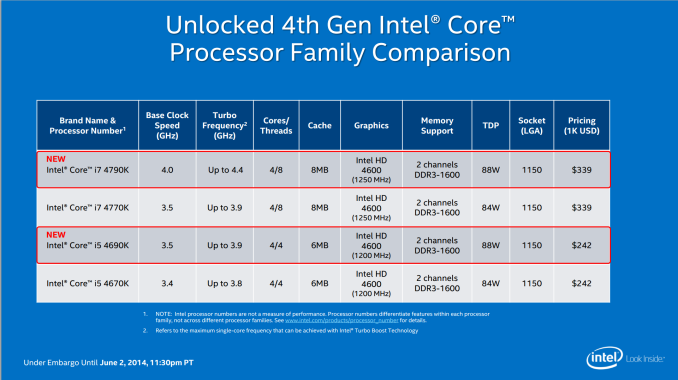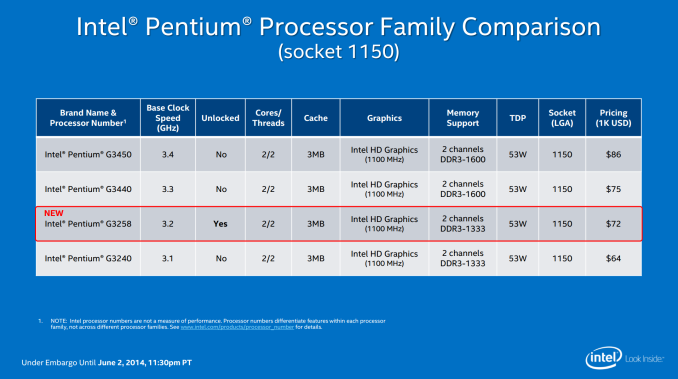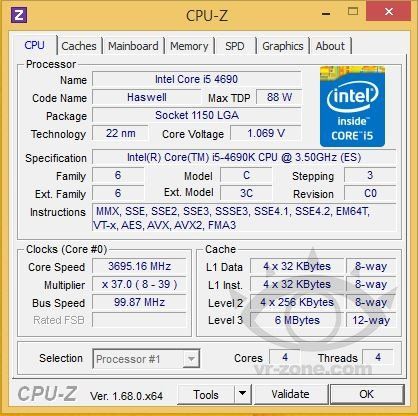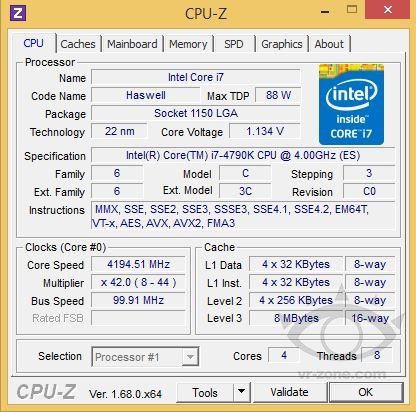Intel Launches Devil’s Canyon and Overclockable Pentium: i7-4790K, i5-4690K and G3258
by Ian Cutress on June 3, 2014 2:30 AM EST- Posted in
- CPUs
- Intel
- Haswell
- Devil's Canyon
- Computex 2014

After what seems like a eon or two since the original announcement, Intel’s Renée James is formally launching the new Devil’s Canyon and Anniversary Edition Pentium processors. In response to enthusiast feedback, and the recent release of the Z97 chipset motherboards, these new processors are designed to improve the overclocking experience for enthusiasts until the next platform enters production.
In the same way as certain other electronic market segments, where the announcement and launch occurs a few weeks before launch, today is actually a paper launch as part of the Computex experience. Review samples for sites like ours should be arriving sometime this week when we can test and dissect the new parts, with a full retailer release later in the month. At present the date is still uncertain: we were hoping to get samples before Computex in order to present results today, but delays have pushed testing and release later down the line. This is in part due to the restricted timescale for these new processors, whereby VP Lisa Graff in a recent press call stated that the Intel engineers had fewer than six months from idea-to-launch.
Devil’s Canyon, the codename for the upgraded Haswell overclocking ‘K’ series SKUs, launches as two parts: an i7 and an i5.
Both models are quad core parts, with the i7 featuring hyperthreading for a total of eight threads. The TDP has a small bump from 84W to 88W, while the official memory support stays at two channels of DDR3-1600. The i7-4790K represents Intel’s first ever consumer processor with a base frequency of 4 GHz (we have CPUs that turbo this high), but the turbo mode for this processor is actually 4-4-3-2, meaning that at single core loads the user will see 4.4 GHz and at full-core loads it will be 4.2 GHz. The i5 is more of a Haswell Refresh-like bump up from its predecessor, with the base frequency and turbo frequencies being moved up a notch.
Compatibility for these processors will be on all Z97 motherboards, and it should extend to Z87 if and only if the motherboard manufacturer has engineered the motherboard to cope with the increased power consumption and also release a relevant BIOS update. I would expect that all the major motherboard manufacturers should announce a full range of 9-series support and a most-of-the-range 8-series support, starting with the most popular products in the 8-series range first (as it all comes down to validation and rewriting BIOS code).
Aside from the base frequency increases, enthusiasts will want to know if the rumor regarding an upgraded package on the CPU is true. I can confirm that Intel has officially made the following changes:
The first upgrade is a new thermal interface material (TIM), which Intel is stating as a ‘next-generation polymer’. This would inevitably imply that the base material is silicone monomer, unless Intel has decided to do something fancy with a carbon-polymer based suspension. With this in mind, users looking to delid their CPUs might see a material the same color as the normal Haswell CPUs, but Intel is stating that this is a new material. One could estimate that another 5-15C shift might occur, allowing those CPUs that were temperature limited to get another 100-200 MHz than they would under the old system. However the issue regarding the height of the heatspreader above the die due to the binding agent has not been mentioned, which would lead me to suggest that it might not have been changed. Until we get a sample in house to test we will not know for sure, but I could perhaps hope that the amount of TIM under the heatspreader has also increased in order to facilitate heat transfer.
For the extreme overclockers using sub-zero cooling, Intel has reworked part of the power delivery around the FIVR to give a cleaner power delivery. Note that none of these changes suggest that any specific change to the underlying silicon die was made, however Intel will be examining the sales of these processors to determine their popularity and whether it is a feature to consider on future platform evolutions.
Also launched today is the new Pentium Processor Anniversary Edition, a fully unlocked 3.2 GHz dual core Pentium and 3MB of L3 cache.
I personally think Intel has missed a trick in not calling this new processor with a ‘K’ moniker, but the 8 on the end should point the CPU out against the myriad of other model names. At $72 for the bulk OEM pricing, this should allow the competitive overclockers to go almost crazy binning (testing to find the best ones) for competitions. The interesting point about the table above is the memory support, set at DDR3-1333. This means that Intel has used a lower bar of entry for the integrated memory controllers on the dies they produce, which might not end well for high memory clocking.
One point of contention for any user that has sought after a high overclocking Haswell CPU in the past is the silicon lottery, whereby CPUs are like chocolate chip cookies. Some cookies have many chips, others have fewer, but the ones made of pure chocolate are the best. Similar analogy to overclocking – some CPUs will hit higher frequencies at lower voltages than others. Haswell processors had a very large swing, with some of the lower performing CPUs (from 3.9 GHz Turbo) only managing 4.2 GHz on air/water cooling compared to the average (4.4-4.5 GHz) and the few awesome ones (5.0 GHz at 1.3 V). Many users tested a half-dozen or a dozen to get the best one of the bunch, and I fear that unless there has been a change at the silicon level, we may see the same with the Devil’s Canyon and Anniversary Pentium models.
CPU-Z screenshots of all three models have been released, confirming many of the details:
As I mentioned, the exact retail release date, as I am writing, is unknown. The embargo for this data is being released at the same time as the Intel Keynote at Computex which is where the official announcing of the new products is happening. Have a read of our live blog on the main page on the keynote to see if an exact date has been chosen! This post will be updated if we get this information.
When we return from Computex we will begin testing the new CPUs, with a plan to show some delidding and see how the new Devil’s Canyon and new Pentium compares to the regular Haswell CPUs both at stock and overclocked. Let me know in the comments if there is anything specific you would like to see in the review.





















53 Comments
View All Comments
Alexey291 - Tuesday, June 3, 2014 - link
why do you bother replying to him seriously? He is comparing an arm octa-core which is these days either a big.LITTLE (aka 4 REALLY slow cores and 4 slow cores) or the one mediatek is making which is simply 8 really slow cores (a7's are terrible yes yes).Unless he is actually stupid (i tend to assume this is not the case usually) he can't be seriously comparing arm cores (especially A7's) to i7 cores...
BMNify - Wednesday, June 4, 2014 - link
"Galatian: You then go on to claim that an Octacore ARM is a somewhat better proposition.""Alexey291:why do you bother replying to him seriously? He is comparing an arm octa-core which is these days either a big.LITTLE (aka 4 REALLY slow cores and 4 slow cores) or the one mediatek is making which is simply 8 really slow cores"
LOL, you two seem very good at reading things into posts that simply don't exist, i don't compare anything to anything here.
i commented that in this update i will look to spend my cash elsewhere (in this case a good quad cortex, next time it will be something else oc) as there's nothing here for ME, the key point being "worth the costs"
"that "i want to actually buy" and is worth the costs , it is not here"
i give a working example of how and why the current i7 is not up to the task for highest quality real time encoding in this case, nothing more.
"I'm little lost here: you spend money for the hack of it?" LOL that's funny, seriously, what use is money other than what it actually gets you, you cant eat it, it doesn't compute data, it might keep you warm for a few seconds on a deserted island if you can use it as kindling , everyone spends money for the heck of it, you work to live or you live to work, ether way you use it to get what you want/need nothing more.
but 4 was best of all, a HEDT processor as of today is a crap "Ivy Bridge-E." that does NOT have AVX2 and its 945.77 US Dollars for a single Intel Xeon 2.3 GHz Processor again NO AVX2 and still using the crappy Intel QuickPath Interconnect (QPI) using A clock rate of 2.4 GHz yields a data rate of 19.2 GB/s...
so your advice to use a so called serious core amounts to a Galatian: fool and his money being wasted by a large margin, research man, then and only then make your choice
Thorburn - Tuesday, June 3, 2014 - link
Its a Haswell speed bump, not a new micro-architecture.i7-4790K looks quite a replacement for the i7-4770K - means the K-SKU is once again the fastest chip at stock as well.
Not sure I see a big argument for a GT3e SKU in the desktop either, the pricing means you're better off just buying a discrete card.
BMNify - Tuesday, June 3, 2014 - link
your assumption is that gfx are the primary reason for wanting a eDRAM GT3e so a discrete card would fit there, however its the eDRAM that makes things like x264 UHD encoding faster here, the GT3 is just a free bonus for http://forum.doom9.org/showthread.php?t=162442 Intel QuickSync Decoder - HW accelerated FFDShow decoder with video processing when you dont want the best visual qualityGalatian - Tuesday, June 3, 2014 - link
But if you are already using quick sync as a fast but cheap solution for encoding h264, why would you spend the extra money on the eDRAM equipped chips just for a few seconds less encoding time. Anandtechs Benchmarks on the Crystal Well chips don't show such a huge improvement.BMNify - Tuesday, June 3, 2014 - link
its not a few seconds and its always about retaining as much visual quality as is possible from the original content, right now for instance im "avisynthesizer" ffmep AVS batching a QTGMC x2framerate encode to keep best quality while doubling framerates at an average of 20FPS and 90'ish%Kevin G - Tuesday, June 3, 2014 - link
One thing not tested is how well the eDRAM scales with clock speeds. Traditionally larger caches showed better improvements at higher clock speeds due to the much slower growth of memory speeds. With a 4.0 Ghz CPU, the L4 eDRAM cache could show more of a tangible benefit than say at 2.4 Ghz.ZeDestructor - Tuesday, June 3, 2014 - link
I don't care for the GT3e very much, but I would like the 128MiB of L4 a lot...dennilfloss - Tuesday, June 3, 2014 - link
That 4790K looks mighty tasty!Acquire - Tuesday, June 3, 2014 - link
I must have one of those 4790K